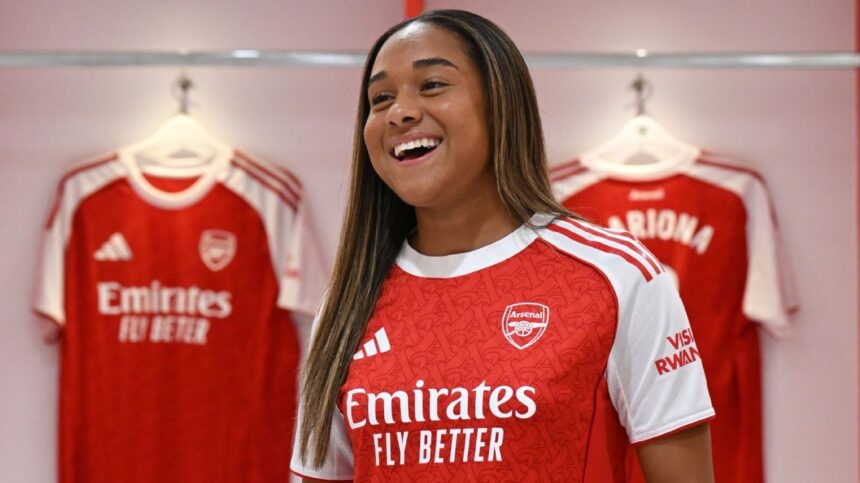Arsenal Women Breaks the Market with the Signing of Olivia Smith
Arsenal has announced the signing of 20-year-old forward Olivia Smith from Liverpool, in a transfer that sets a new world record in women’s football. The Canadian international becomes the first female footballer to surpass the £1 million mark ($1.36 million), breaking the previous record set by Naomi Girma’s transfer to Chelsea for £900,000 ($1.1 million) in January. This signing adds to the additions of Chloe Kelly and Taylor Hinds, strengthening the squad after the victory in the UEFA Women’s Champions League in May. Smith, who debuted as an international with Canada at 15 years and 94 days old, caught attention since his time at Sporting CP, where he scored 13 goals in 18 matches during the 2023-24 season.- Transfer market analysis: Arsenal gets an A for Smith’s signing
- History of the women’s world transfer record: Smith surpasses Girma
In what position does he play?

What are your strengths?
His main strengths lie in his dribbling ability. He has a lot of speed, but also the ability to change direction instantly, opting to go inside or outside equally, which adds unpredictability to his game. His control in tight spaces and his ability to overcome challenges also make him a nightmare to defend.
Smith played in a Liverpool team that was direct in its build-up, which limited her time and touches on the ball, but she was excellent when she had it in possession. The statistic of “progressive carries per 100 open-play touches” gives an idea of how often a player attempts a progressive carry, and the winger is in the top quartile for both dribble attempts and normalized progressive carries among forwards. She’s in good company alongside Chelsea players Johanna Rytting Kaneyrd and Mayra Ramírez, both known for their ball control, and is also joined by her new Arsenal teammate, Caitlin Foord. In fact, Smith’s 3.6 attempted dribbles (with a 58% success rate) also place her in the top group and suggest some stylistic similarities with Foord, which is promising for her adaptability. Smith also likes to shoot. Although primarily right-footed, she is good with both feet and took 49 shots last season, the sixth-highest figure of any player in the WSL. That’s a feat considering Liverpool’s general lack of chance creation, and Smith often had to create opportunities for herself using her speed and ability to create space. Only Aston Villa players Kirsty Hanson and Ebony Salmon, as well as Kerolin of Manchester City, created more shots from dribbles (9) than Smith (8). And no player scored more opportunities than her (2). Smith’s quick feet and repertoire of skills make her difficult to read and allow her to draw fouls. Only West Ham’s Viviane Asseyi (51) won more fouls than Smith (46) in the WSL last season, and nine of them resulted in a shot attempt in the following two actions. The young woman also has the ability to stand out against the big teams. She caused many problems for Arsenal in their FA Cup quarter-final tie and scored against Chelsea, Manchester United and Manchester City in all competitions last season.
What do you need to improve?
There are questions about how Smith will play in a team that dominates possession more. The winger played on a Liverpool team that averaged 47.4% possession last season and relied on transition opportunities, often against disorganized defenses with plenty of space to run. However, Arsenal averaged the second-highest possession in the WSL last season (62.5%) and consistently faced established defenses in a low block with players behind the ball. While Smith’s quick feet are an important part of his dribbling arsenal, the lack of space in the backfield could hinder the impact of his dribbling overall, potentially resulting in some unwanted ball losses and a slight decrease in his dribbling success rate.How will Smith fit into Arsenal’s tactical plan?
Renée Slegers retained some key aspects of Jonas Eidevall’s tactics after replacing him in October, but also added her own touch. Under her direction, Arsenal’s wingers are asked to move the ball up the field due to their direct ball-carrying nature, especially since the arrival of Chloe Kelly, but they are also entrusted to shoot and cross the ball frequently.Without the ball, however, they are expected to contribute to the team’s pressure and engage with the opposing defensive line in their own third. Smith fits like a glove in this philosophy; she is an active defender with a brilliant work rate and is always a key component of her team’s offensive approach.
Only Arsenal’s Mariona Caldentey (24) made more entries in the final third than the Liverpool star (20) last season. And, among the forwards, only Manchester United’s Celin Bizet (98), Chelsea’s Kaneryd (90) and Asseyi (88) made more ball recoveries than Smith (77) last season.









